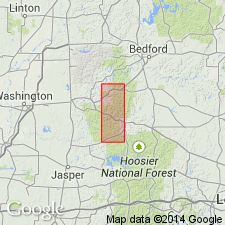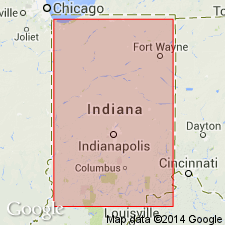
- Usage in publication:
-
- Lagro formation
- Modifications:
-
- First used
- AAPG geologic province:
-
- Cincinnati arch
Summary:
Shown on diagram of formations of Pleistocene age in Indiana. Name appears above Trafalgar formation (new). Name credited to W.J. Wayne (in prep).
Source: GNU records (USGS DDS-6; Reston GNULEX).

- Usage in publication:
-
- Lagro Formation
- Modifications:
-
- Named
- Dominant lithology:
-
- Clay
- Silt
- Till
- AAPG geologic province:
-
- Cincinnati arch
Summary:
Name Lagro Formation formally proposed in this report for Pleistocene deposit in northeastern IN. Consists of three laterally intertonguing parts that are here treated as members. Easternmost member, herein named New Holland Till Member, and westernmost member (unnamed) are distinctive in their high clay and low sand content. Central member (unnamed) does not share this lithologic distinction. Thickness 24.5 ft at type section; 22.5 ft at reference section. Overlies Trafalgar Formation. Tongues and lenses of both Martinsville and Atherton Formations overlie Lagro. Age is late Wisconsinan. Correlates, at least in part, with deposits of Cary Substage and with deposits of upper part of Woodfordian Substage.
Source: GNU records (USGS DDS-6; Reston GNULEX).
For more information, please contact Nancy Stamm, Geologic Names Committee Secretary.
Asterisk (*) indicates published by U.S. Geological Survey authors.
"No current usage" (†) implies that a name has been abandoned or has fallen into disuse. Former usage and, if known, replacement name given in parentheses ( ).
Slash (/) indicates name conflicts with nomenclatural guidelines (CSN, 1933; ACSN, 1961, 1970; NACSN, 1983, 2005, 2021). May be explained within brackets ([ ]).

